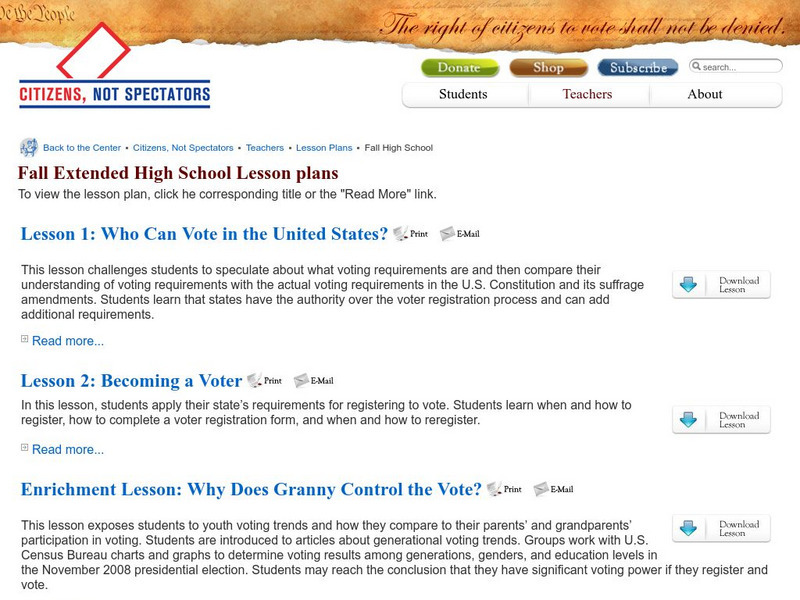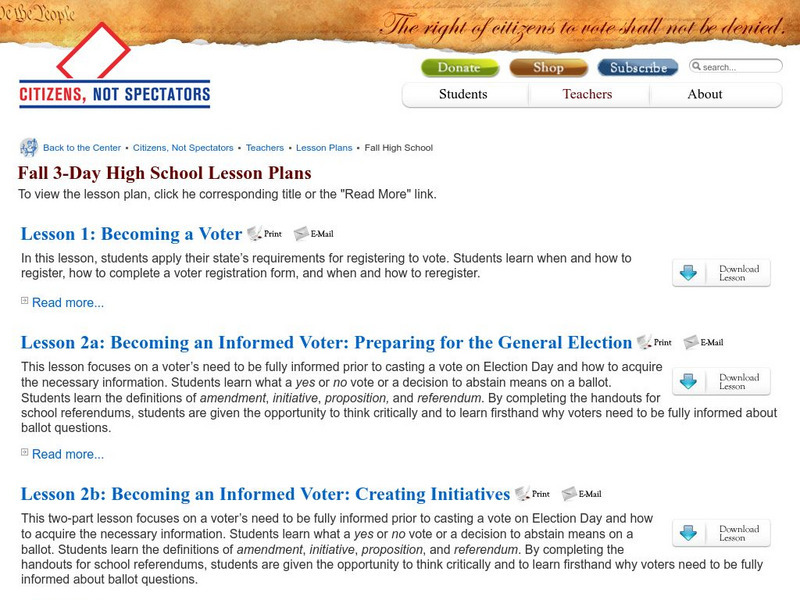Hi, what do you want to do?
Curated OER
Do You Have a Coin Collection?
Learners create a graph showing which students in the class collect coins.
Curated OER
Christmas Tree Farming in Ontario
Students realize that Christmas trees produced in Ontario are a field crop that is harvested annually. They find out that Christmas tree farming is important to the economy and the environment of our province.
Curated OER
Who Says?
Students evaluate websites for scientific accuracy and usefulness. They explore various content evaluation criteria and observe a demonstration on evaluating web sites. They select and evaluate a website for its content information on a...
Curated OER
M&M Statistics
Students determine the difference between guessing and making a prediction. They discuss what they could graph using a bag of M&M's. They take a Raw data sample and convert it into a sample. They graph the actual results and combine...
Curated OER
Electronic Elections
Students evaluate the role of voting in democratic societies and the potential of voting on the Internet.
Curated OER
And Now, the News from Iraq
Students consider the challenges facing Iraqi voters and various attitudes toward the election. They research topics related to the January 2005 election, then write segments for a television news hour.
Curated OER
Underground Railroad
Students research and discuss the use of the Underground Railroad by fugitive slaves. They debate the actions of abolitionists and slave owners according to the laws of the time, create drawings and write narratives.
Curated OER
Women's Rights Ancient Egypt and the United States
Students explore the rights of women in the United States and ancient Egypt. Comparisons between the two eras and countries are made as the wealth, business, marriages, court cases, divorces, and employment of women are probed.
Curated OER
Database Detectives Record Clues
Students collect and organize data from their classmates. They create a database of the information and analyze it. They discuss the role technology has in the world today.
Curated OER
How Psychologists Do Research
Students discover how psychologists complete their research on different topics. In groups, they describe the elements of an experiment and the importance of sampling during research. They identify ethical issues in their research and...
Curated OER
Hazelwood v. Kuhlmeier
Middle schoolers read the case text of the Hazelwood v. Kuhlmeier case. Using the text, they discuss the case history and the implications of the verdict. They share their findings with the class in the form of a PowerPoint presentation...
Curated OER
Whose Business Is It?
Students read articles in The Times Business Day section and share their opinions on the articles. They search through the Business Day section of The Times to find items to complete a scavenger hunt. They summarize a teacher selected...
Curated OER
Breaking News English: Speed Limits Proposed on the German Autobahn
In this English worksheet, students read "Speed Limits Proposed on the German Autobahn," and then respond to 47 fill in the blank, 7 short answer, 20 matching, and 8 true or false questions about the selection.
Curated OER
Breaking News English: Russia Issues 5000-Rouble Note
In this English worksheet, students read "Russia Issues 5000-Rouble Note," and then respond to 47 fill in the blank, 7 short answer, 20 matching, and 8 true or false questions about the selection.
Curated OER
Breaking News English: Africa Gets First Elected Female President
In this English worksheet, students read "Africa Gets First Elected Female President," and then respond to 47 fill in the blank, 7 short answer, 20 matching, and 8 true or false questions about the selection.
Curated OER
Breaking News English: German Election Turmoil
In this English worksheet, students read "German Election Turmoil," and then respond to 47 fill in the blank, 7 short answer, 20 matching, and 8 true or false questions about the selection.
Curated OER
Breaking News English
In this ESL worksheet, students read the article entitled "Average Workers Waste Two Hours a Day." Students respond to 51 short answer, matching, true/false, and fill in the blank questions.
Curated OER
Breaking News English: British Food Best in the World
In this English worksheet, students read "British Food Best in the World," and then respond to 47 fill in the blank, 7 short answer, 20 matching, and 8 true or false questions about the selection.
Curated OER
Breaking News English: Kate Moss Best Dressed and Undressed
In this English worksheet, students read "Kate Moss Best Dressed and Undressed," and then respond to 47 fill in the blank, 7 short answer, 20 matching, and 8 true or false questions about the selection.
Center For Civic Education
Center for Civic Education: Fall 5 Day Brief Lesson Plans on Voting
A set of brief lessons on voting. Topics covered include voting requirements, registering to vote, voting trends, voter self-education, setting up a polling station, and simulating an election polling site that coincides with a real fall...
Center For Civic Education
Center for Civic Education: Fall Extended Lesson Plans on Voting
An in-depth set of lessons on voting. Topics covered include voting requirements, registering to vote, voting trends, voter self-education, setting up a polling station, and simulating an election polling site that coincides with a real...
Center For Civic Education
Center for Civic Education: Fall 3 Day Lesson Plans on Voting
A set of three lessons on voting. Topics covered include voter registration, educating oneself prior to voting, and simulating an election in class that coincides with a real fall election. All lessons can be downloaded.
TED Talks
Ted: Ted Ed: Pros and Cons of Public Opinion Polls
How do public opinion polls work? And, more importantly, are they accurate? Jason Robert Jaffe reveals the complexities and biases of polls and provides tips on how to think about polls as we make everyday decisions. [4:25]
iCivics
I Civics: The Poll Picture (Infographic)
Use this infographic to show the process of surveying from pollster to prediction. Students will engage with the concept of sampling and gain a better understanding of the purpose of public opinion polls.




























